This case involves a worker who was using an electric forklift at a plant. The worker was using the forklift to load empty plastic beverage pallets into a commercial trailer. While the worker was loading the pallets, several of the pallets moved off center and the worker tried to manually realign them. The worker got out of the operator’s seat of the forklift and, without having to touch the ground, swung his body into the area between the forklift’s operator’s cage and its telescoping mast. The worker positioned one of his feet on one of the mast’s lower crossbeams while his other foot was suspended in the air off the forklift’s left side. While he was repositioning the pallets, the forklift’s mast moved toward his abdomen and he was pinned against the forward portion of the overhead guard. The mast kept moving to the rear and crushed the worker’s abdomen. The worker suffered severe abdominal crush injuries and resection of his colon and ileum. He died a few days later as a result of his injuries.
Question(s) For Expert Witness
1. Does the design of an electric forklift make it unreasonably dangerous, and could this cause a worker to be crushed if he gets out of the operator’s cage?
Expert Witness Response
Forklifts are very dangerous because they are heavy—most forklifts weight as much as a regular dump truck. One of the main dangers to forklift operators is that the operator may get caught between the parts of the machine while trying to reposition materials that are being loaded. If a forklift operator is crushed by the machine’s overhead guard, this can cause serious injury or death. A forklift is equipped with a cage around the operator’s area and has several control levers on the right of the forklift’s steering wheel. These levers are used to adjust the forklift tines and mast. If a forklift operator must leave the operator’s cage to reposition a pallet, he is usually required to engage the forklift’s emergency brake before leaving the operator’s cage. A forklift operator is never supposed to be in the area between the forklift’s upright masts and the operator’s cage while the machine is running because they could be crushed. In this case, the forklift’s design may have caused the injury because it had an unguarded pinch point that the worker wasn’t warned about. Some forklifts are equipped with a safety seat switch system that is supposed to cut off all electricity to the machine and render it inoperable if the operator is not seated in the operator’s seat. The problem with the design of many of these switches is that they are prone to fail and may allow the forklift to remain energized even if the operator is not in their seat. This means that the seat switch on many forklifts may not prevent a crush injury like the one in this case. The manufacturer of the forklift should have designed the machine with a sensor device attached to the forklift’s seat belt that would have disconnected the forklift’s power if the operator got out of his seat.
About the author
Inna Kraner, J.D.
Inna Kraner, J.D., is currently Associate Director of Development - William S. Richardson School of Law. She worked in client development at Proskauer Rose LLP, and held various marketing positions at Skadden, Arps, Slate, Meagher & Flom LLP. She has experience litigating corporate, industrial, financial, regulatory, and controversy matters. Inna graduated with a J.D. from Boston College Law School and a B.A. from Brandeis University.



